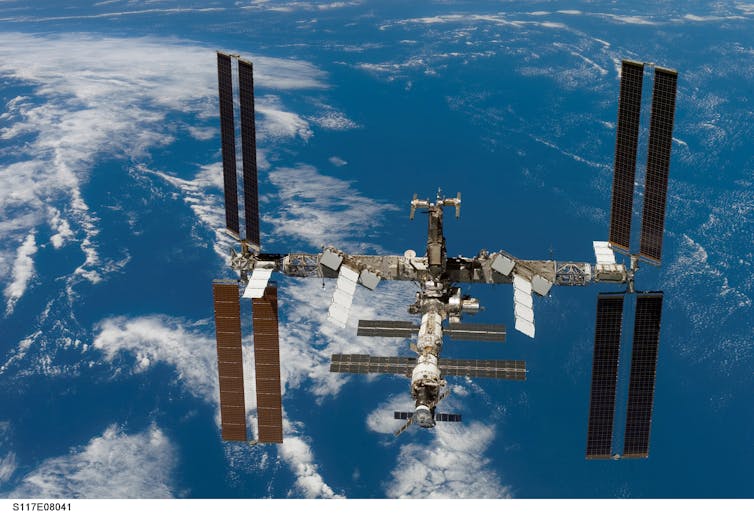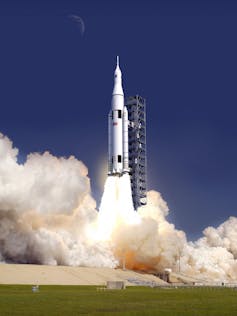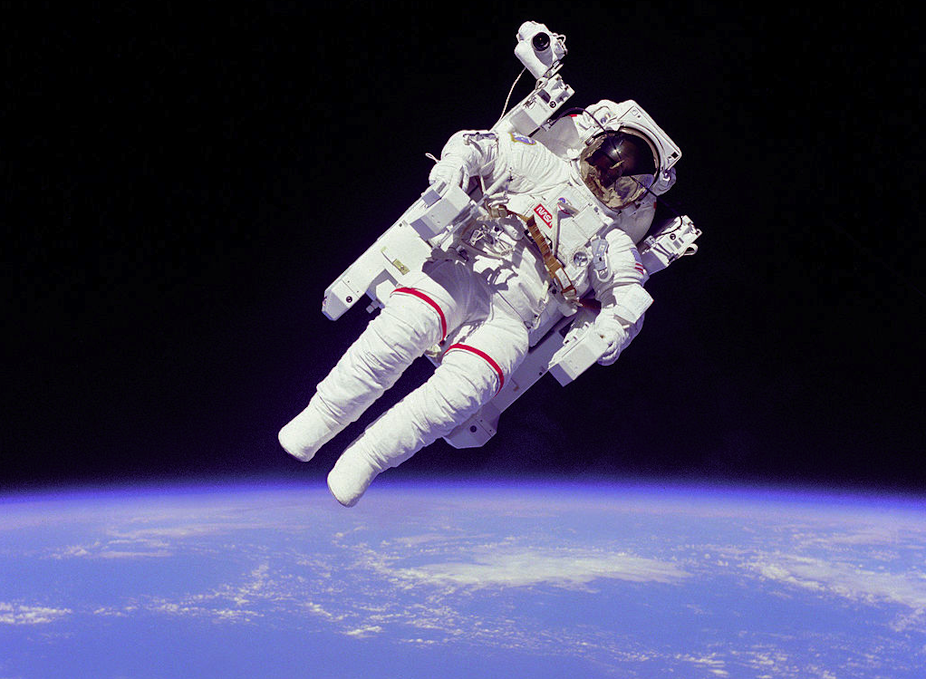NASA is currently poring over more than 6,000 applications for the next intake in its astronaut program - from which nine to 15 candidates will be successful. And while the Space Shuttle program is a thing of the past, the agency is still training astronauts for a range of future missions.
The Conversation spoke with Greg Chamitoff, NASA astronaut and crew member on the penultimate flight in the Shuttle program, about the astronaut program and what the astronauts-in-training can expect.
What will NASA be looking for in the astronaut candidates?
Despite the fact we’re in a gap between US launch capabilities, there are many great plans for exploration beyond Earth orbit in the decades ahead.
Whoever is lucky enough to get selected this time will likely be among the first to explore deeper into space than we’ve been in the last 40 years. In the meantime, we have a spectacular, massive and research-capable Space Station in orbit, the International Space Station (ISS).
Between now and 2020 (and hopefully well beyond) we’ll be maximising our use of that international outpost to prepare for missions to more distant targets.
The people selected for these missions will need to be able to live and work in space for many months, possibly years, at a time. My sense is that NASA will be looking, first and foremost, for candidates that are well-balanced people that can get along with others, work hard for long periods under stress, and maintain a positive attitude.
All of the usual skills and experience you would like to have in an astronaut will be part of the default requirement as well, of course, including:
- relevant higher education (engineering, science, medicine etc.)
- work experience
- leadership skills
- demonstrated expertise in relevant fields such as engineering, science or medicine.
The next generation of space explorers will also be an international group, and so candidates who speak other languages and have overseas experience will probably be better qualified.

What’s next for those lucky few that get through the selection process? What’s involved in astronaut training?
Once the new group is selected, they will hopefully have a similar experience to the one I enjoyed during my training for long-duration flight on the Space Station.
The training is very diverse and in locations all over the world. Initially there will be basic training, primarily in Houston.
It takes about a year to learn the essentials of what goes on at NASA, on the Space Station, and everything technical and operational about how things work. Everyone needs to learn how to fly NASA T38 jets.
Flying is actually one of the few “real-world” operational types of training we have. Almost everything else we do in training is a simulator of some kind.
That said, we do have certain expedition training trips that put a crew in an environment that can be treated as a space-flight analog.
One of these is an underwater research facility off the coast of Florida called Aquarius.
Future Space Station crew members spend a week or two living under the sea to emulate the conditions and some of the operations they would perform on the Space Station or a future exploration mission.
Survival training is part of the initial training, and later there are leadership training and team-building exercises that are performed in stressful environments.
Some of this training has direct application to space missions, but some of it is simply to discover personal limits and to develop the tools and techniques for operating as a team under difficult conditions.

Once assigned to a mission, the training becomes more specific to understanding how to operate the spacecraft systems, hardware, software, experiments and tools.
With 15 countries involved, a dozen different modules onboard the Space Station and perhaps 150 experiments going on at once, there’s a lot to learn.
Almost half of the training will be in Russian. As a result, everyone will eventually learn enough Russian to operate the systems on the Station and in the Soyuz capsule.
Dinner conversations in space these days are in half-English, half-Russian, so it’s important to know a bit of Russian.
Training for a long-duration spaceflight is the adventure of a lifetime all by itself. But, of course, it hopefully leads to a much grander adventure beyond our planet.
What’s life like for an astronaut candidate?
Preparing for a long-duration mission takes several years. In fact, if someone were to be assigned today their launch would be about three to four years in the future. As such, training for an upcoming mission is a big part of what astronauts are doing when they’re not in space.
I’ve been in the Astronaut Office for 13 years and spent about eight of those years focused on training. Otherwise, though, we are literally involved in every aspect of human spaceflight operations.
We support the current mission and we help develop all the tools, techniques, hardware, software, displays and procedures for everything we plan to do in space in the future.
If something is going to be done by an astronaut in space, another astronaut has probably contributed to making sure it is designed to work well once it gets there.
During the mission itself, an astronaut on the ground is often the person talking to crew from mission control. Luckily for us, NASA recognises the value of treating astronauts as the ultimate customers of everything that is developed for human spaceflight, so we get to provide input to the design process.
Otherwise, even if we’re not assigned to a mission, we have to maintain our skills on the things we’ve been training on. So some of our time is always dedicated to training.
We also do public relations events quite frequently and support a wide range of management and other activities within NASA or overseas, working with our international partners.
With the Shuttle program now a thing of the past and few (if any) manned missions on the horizon, is the NASA astronaut a threatened species?

While the Shuttle was flying and we had crew living on the International Space Station, we were launching roughly 40 to 50 people a year.
Now the Shuttle is retired and we only have long-duration space-flyers, there are essentially 12 people a year in space – half being Russian, three or four Americans and the rest being European, Canadian or Japanese astronauts.
It’s a big change in the flight rate and this situation will continue until we’ve developed a new launch vehicle to go beyond low Earth orbit.
It’s possible we might see a slight increase in the launch rate once commercial transportation for crews becomes available in several years. But if the ISS is the only destination then it won’t change that much.
Once the Space Launch System (SLS) is ready to fly missions beyond Earth orbit we will see the number of humans in space increase again.
Nevertheless, we are hiring new astronauts now for two reasons. First, the attrition rate has gone way up with the retirement of the Space Shuttle program.
For one reason or another, many astronauts were qualified to fly on the Space Shuttle and were not going to be (or didn’t want to be) qualified for long-duration flight.
Second, the lead time for ISS training and future missions is long enough that we need to maintain a qualified core of astronauts taking into account future attrition.
In order to keep a steady flow of crew members in training for ISS missions and to support all the other activities we do, we need about 50 to 60 active astronauts in the corps.
While this is significantly less than what we had ten years ago, it is still a sizable group of astronauts. It’s also true that while the flight rate is low right now, it is expected to increase from here on in.
Perhaps this is the calm before the storm, when humanity will truly expand into the cosmos in much greater numbers. Several private space vehicles are currently in development and once space operations become commercially profitable the sky will no longer be the limit.
How will the experience of being a new astronaut candidate in 2013 differ from your experience in 1998?

The truly exciting thing on the horizon for future astronauts is that we’ll be pressing on further from Earth in the years ahead.
While I hoped visiting Mars was within my reach someday, I was born a generation too early. Astronauts we are hiring now are very likely to get a view of Earth from much farther away than I did during my tour on the International Space Station.
Perhaps they’ll land on the moon, explore the surface of an asteroid or go to Mars. In ten to 15 years or so, we will be launching some of these missions.
Within 20 to 30 years we’ll probably have other bases around the solar system. What we have learned during the Space Shuttle program and on the International Space Station is incredibly valuable toward making all this possible.
The construction of the massive and vast space station was a spectacular engineering feat, and every day we are gaining experience with the technology we’ll need to live, work and conduct scientific investigations throughout the solar system.
Most of the missions ahead will involve longer durations than the six months I spent on the ISS. So the lessons learned from the current program will be invaluable as we go forward.
The future holds great promise – I wish I could apply to NASA to start all over again.

